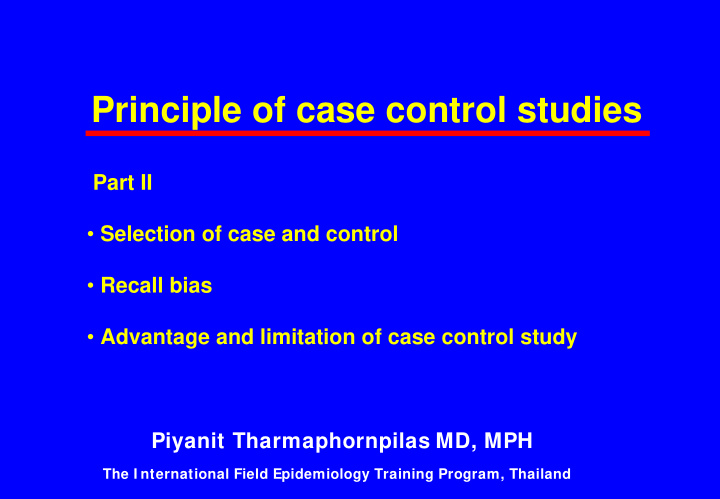



Principle of case control studies Part II • Selection of case and control • Recall bias • Advantage and limitation of case control study Piyanit Tharmaphornpilas MD, MPH The I nternational Field Epidemiology Training Program, Thailand
Who is a case ? All (or randomly sampling) people within the source population who develop the disease of interest Source population � population within a geographic boundary � population attending a single clinic � population under a specific registration � population involving in an occasion e.g. a wedding party � etc.
Who is a control ? � A control do not have disease in question � A control should be selected from the same source population as the case � Controls must be selected independently of their exposure status � Controls must be subject to the same inclusion and exclusion criteria as cases.
Population controls All (or randomly sampled) people within the source population who do not develop the disease of interest The most desirable option To obtain population controls: � the source population must be identified explicitly � simple random sampling must be feasible
Neighbourhood controls After a case is identified, controls who reside in the same neighbourhood are recruited into the study Advantages and limitations: � easy to do � good and convenient when source population is from a geographic boundary � possible bias if population in the neighbourhood have different characters from source population
Hospital-based controls Controls are recruited from the same hospitals or clinics as the cases. The source population: � people who would be treated in a given hospital or clinic if they developed the disease in question Advantages and limitations: � preferred when cases are from hospitals or clinics (taking into account the referral patterns) � possible bias if general patients seen at the hospital have different characters from source population
Friend controls Cases are asked to listed their friends and controls are chosen from the list Advantages and limitations: � easy to do � possible bias friends may have similar exposure or habit as cases than others (this may reduce OR in the study) � possible bias extroverted people are likely to be named as friends, so, exposures more common in extroverted people are likely to become over-represented among friend controls
Dead controls Controls are a member of the source population for cases, but died from other causes Advantages and limitations: � convenient when studies based entirely on deaths � controls cannot be interviewed since they already died � possible bias exposure distribution in death may be different from others who are alive
Limitations of case-control studies � Cannot compute relative risk directly � Not suitable for rare exposure � Temporal relationship exposure-disease difficult to establish � Possible biases +++ � control selection ”selection bias” � information bias ”misclassification” and ”recall biases” when collecting data � What is recall biases
What is recall bias Bias due to differences in accuracy or completeness of recall to memory of prior events or experience Mothers whose children have had leukemia are more likely than mothers of healthy living children to remember diagnostic x-ray examinations to which these children were exposed in utero.
Advantages of case control studies � Rare diseases � Long latency diseases � Several exposures � Rapidity � Low cost � Small sample size � Available data � No ethical problem
End of part I I
Recommend
More recommend